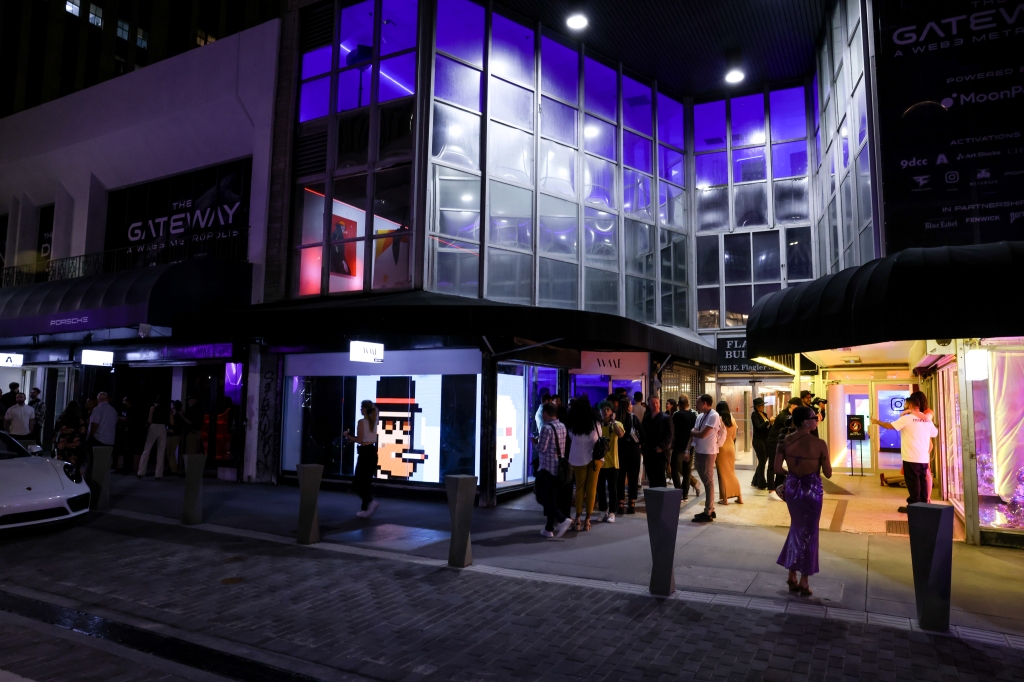By Shanti Escalante-De Mattei
Last night, Miami mayor Francis Suarez spoke to a small group of crypto and NFT enthusiasts to officially unveil the exhibition “The Gateway: A Web3 Metropolis.” It was the second year in a row that the Gateway—a festival put together and funded by by nft now, a web3-focused publication; Mana Common, a real estate development company owned by billionaire real estate mogul Moishe Mana; and MoonPay, a crypto trading app—had come to Miami, and this time around, the mood was a lot different.
“This is the last time that we’re going to completely be in the physical world,” Suarez said. “Right? Last time.” But he didn’t sound too bummed out about it.
blogherads
.defineSlot( ‘medrec’, ‘gpt-dsk-tab-mid-article1-uid0’ )
.setTargeting( ‘pos’, [“mid-article1″,”mid”,”mid-article”,”mid-articleX”] )
.setSubAdUnitPath(“ros/mid-article”)
.addSize([[2,2],[300,250],[300,251]])
;
});
As he welcomed the coming of a digital world, a “world without limits” where inner city kids could go to Harvard, virtually for free, he started out his talk thanking Mana for his investment in Miami, a real, physical place.
The Gateway was set up along Flagler Street, with storefronts for the Gateways partners, which included Porsche; the generative art platform Art Blocks; RTFKT, which produced Murakami NFTs; and Adam Bomb Squad, a streetwear company. Mana and Suarez are in the midst of redeveloping the area, and it this isn’t the first time they’ve done this kind of work together.
Mana’s claim to fame is having redeveloped Wynwood, a Miami neighborhood. Wynwood used to be cheaper, a little grittier, mostly made up of warehouses, but it supported a thriving arts scene, with over 70 galleries there. In recent years however, as projects like MANA Wynwood have helped turn the district into a tourist hotspot, the neighborhood is now more known for its Instagrammable murals and nightclubs.
Wynwood would become the center of the crypto community in 2021, with many crypto companies, like Blockchain.com, Solana, and Ripple, setting up their offices there.
Now, Mana has invested some $500 million in this new endeavor to revitalize downtown Miami. It all began with a phonecall.
“One day, Moishe calls me, as he does almost every day. He says, ‘Mr. Mayor, I saw the plans for Flagler Street,” Suarez said in his remarks at the Gateway. “He said, ‘You’re gonna redo the street, but I think it’s a $10 million project, and I’m going to spend my own money to redesign and re-envision the project.’ I say, ‘Okay Moishe, it’s your money…’”
In the end, Mana increased his investment to $500 million, and Suarez pulled strings to get additional funding from Miami County.
A big part of this vision includes drawing crypto and NFT money into the city, which Suarez has long been pushing for, with varied results. When the going was good, traders flush with highly valuable Bitcoin could pay for bottle service using crypto, but as the market has downturned, Miami club owners have lost out on that particular cash cow, reported Insider. FTX, which made its home in Miami with the FTX Arena, is another embarrassment.
However, Suarez pushes on, and insists he still gets his salary paid out in Bitcoin, according to Bloomberg.
Everyone at the Gateway opening seemed intimately familiar with the high highs and the low lows of the crypto market. Like Suarez, they didn’t think that a few months of bad business made the dream of digital ownership any less legitimate.
After Suarez finished his remarks, he, the Gateway team, media, and whoever else wanted to come headed to the former City National Bank building across the way, which Mana bought in 2019 for a cool $25 million. Up the elevator, purple lights and pulsing screens awaited. nft now founders Matt Medved and Alejandro Navia gave Suarez a tour of a section of the exhibit. Cameras filmed as a projector shone on Suarez’s face. “This is great!” he said, thrumming with energy. Meanwhile, Mana, in the crowd, looked tan and weary.
They led Suarez to a collection of works displayed in the bank’s vault. Works by popular NFT artists like Beeple, Tyler Hobbs, IX Shells, and Mad Dog Jones were on view. Some of them are for sale on Christie’s 3.0, the house’s NFT auction platform. At one point, Suarez leaned in to better regard one of the screens, put his hands behind his back, and made a face of focused consideration.
“Wow, look at the detail on that. That’s just amazing,” he said. A turn around the room, and the mayor and the Gateway team went to a well-lit area for pictures.
After the mayor left, the Gateway team could take a breather before the evening party started. Reflecting on the project, Medved and Navia spoke of the Gateway as being the result of their calling to educate the world about NFTs.
“It’s really about empowering artists and trying to onboard as many people as possible,” Medved said. “We see the Gateway as this glimpse into the future of art, digital ownership, what our lives are going to look like.”
The World's Premier Art Magazine since 1913. Subscribe today and save up to 29%!
Sign Up for our Newsletters
Get our latest stories in the feed of your favorite networks
We want to hear from you! Send us a tip using our anonymous form.
Subscribe to our newsletters below
ARTnews is a part of Penske Media Corporation. © 2022 Art Media, LLC. All Rights Reserved.


